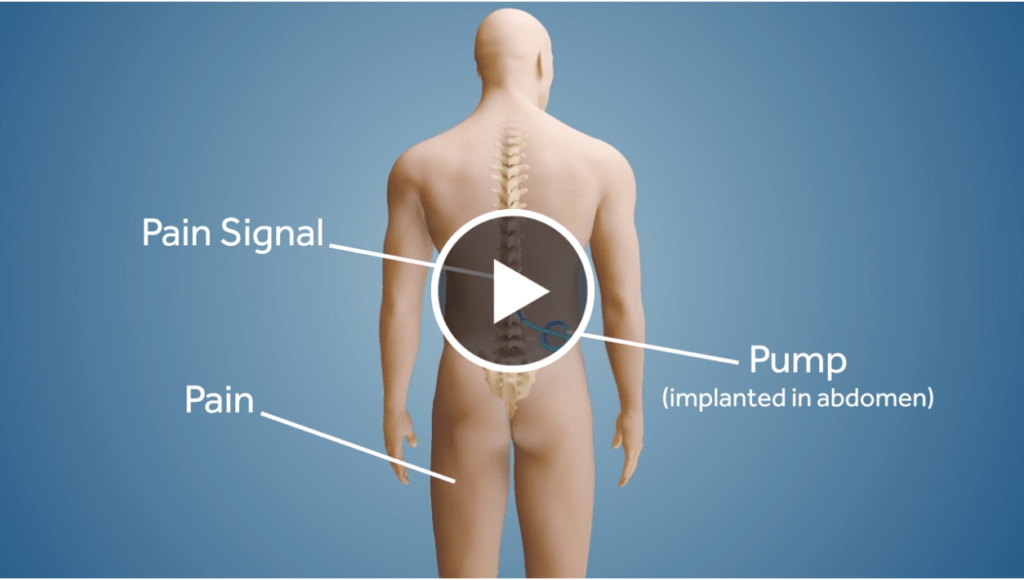Intrathecal Drug Delivery and Benefits
Chronic pain is a main reason that people seek medical care and it is related to mental and physical conditions along with a significant loss in productivity.
In 2016, a little over 20%
of people
in the U.S. had chronic pain.
Chronic pain is often linked to limited mobility along with limited ability to perform daily activities. It is also often followed by anxiety & depression.
Read: Prevalence of Chronic Pain and High-Impact Chronic Pain Among Adults — United States, 2016
Benefits of Chronic Pain Targeted Drug Delivery
- Improved quality of life & ability to function
- Pain Relief
- Reduction in oral medication
- More cost-effective than conventional treatments


Pain pumps may be beneficial in patients with:
- Chronic severe pain
- Chronic regional pain syndrome (CRPS)
- Failed back surgery syndrome (continued chronic pain after surgery)
- Cancer-related pain
- Arachnoiditis
- Others
Pain pumps can also help with spasticity that often occurs in patients with:
- Cerebral palsy (CP)
- Multiple sclerosis (MS)
- Stroke
- Brain injury
- Spinal cord injury
Experienced clinicians dedicated to bringing you the care you deserve.
Benefits of Targeted Drug Delivery
Medication delivered through a pump is targeted directly to the cerebrospinal fluid (CSF) around the spinal cord vs oral medication that has to be distributed throughout the body. Therefore, medications delivered through the intrathecal pump can be given at less than 1% of the dose of oral medication.
According to Medtronic.com:
Patients report a reduction in pain scores after receiving targeted drug delivery.
- 51% of patients completely eliminated other opioids* at 12 months.
- 87% of patients rated their quality of life as fair to excellent.
- 90% of patients would recommend therapy to a family member or friend.
Targeted drug delivery utilizes an implanted, programmable pump to release specific doses of medication for pain or spasticity through a catheter directly to the cerebrospinal fluid (CSF) around the spinal cord.
“Intrathecal drug delivery offers patients a way to experience pain relief using a fraction of an oral medication dose,which can help to minimize the uncomfortable and sometimes intolerable side effects (e.g., drowsiness, dizziness, nausea, vomiting and constipation) that often accompany pain medication taken orally.”
Targeted drug delivery can also provide pain relief in patients who cannot achieve adequate analgesia even with high doses of oral opioid medications.
About the Pump
The intrathecal pump delivers a small dose of medication directly to the cerebrospinal fluid (CSF) around the spinal cord to help with chronic pain and/or spasticity. Many individuals have experienced great relief from utilizing the intrathecal pump system. After a successful trial to determine if the pump will be effective, the pump will be surgically implanted.
The pump resembles and is approximately the same size as a hockey puck. It is usually placed in the right or left lower abdomen. A catheter is attached to the pump and tunneled around the person’s side to reach the spinal column. The catheter is secured into the intrathecal space in the spine.
Both the pump and catheter are not visible by just looking at the skin. The whole system is completely implanted in the body.
The pump is programmed by a specific programming device to deliver medication as ordered by your managing physician. The medication will run continuously at a programmed rate from the pump reservoir through the catheter into the intrathecal space in the spine.
Synchromed™ II Intrathecal Pump
Prometra® Pump
For Patients & Families
Hear stories from patients about their reasons for getting a pump and their experiences with the pump. Watch various videos to see patient experiences with why they needed a pain pump and how it helped them.
Related Literature
Patient Satisfaction Following Intrathecal Targeted Drug Delivery for Benign Chronic Pain: Results of a Single-Center Survey Study
David M Schultz, Vwaire Orhurhu, Faizan Khan, Jonathan M Hagedorn, Alaa Abd-Elsayed

